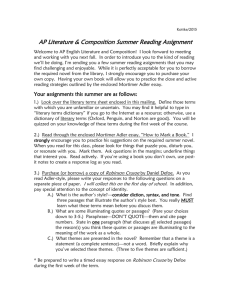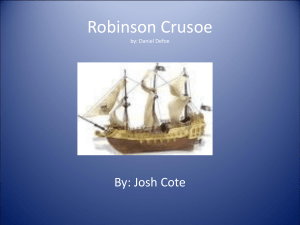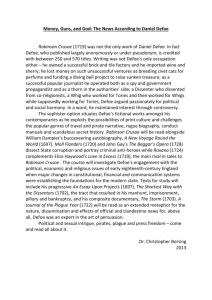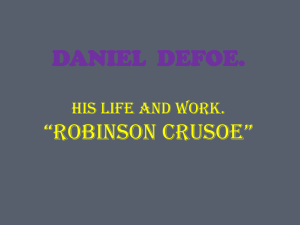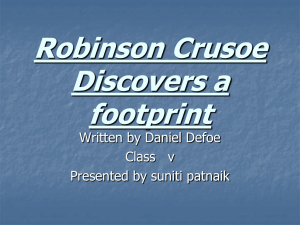Daniel Defoe - Background
advertisement
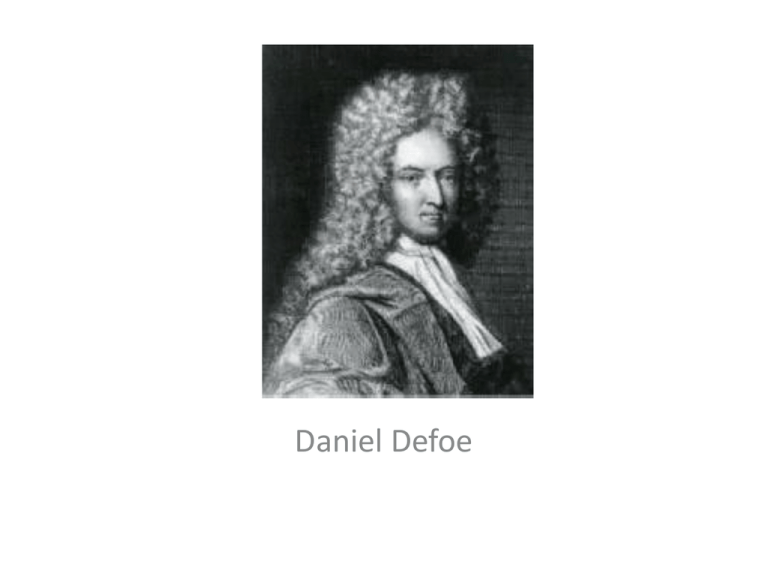
Daniel Defoe Background of the Author • Daniel Defoe has been called the father of journalism. To many of his contemporaries, he was a man who sold his pen to the political party in office and so lacking integrity. • He was a Puritan, the son of a butcher, and a suspected government spy (this suspicion was confirmed in the nineteenth century). Defoe was not a gentleman born or raised though he aspired to be one and changed his name from Foe to Defoe and bought a coach. • Defoe received widespread and consistent serious critical attention in the twentieth century, and his works have been subjected to modern interpretations, e.g., Marxist, psychoanalytic, feminist, and poststructuralist. Success of Robinson Crusoe • With six printings in four months, Robinson Crusoe was a popular and financial success in 1719. • Because of Robinson Crusoe's success and of its universal appeal, the novel continued to be published for over two centuries. • It has been packaged as a picture book with little or no text; this degradation was consistent with a tendency to view it as a children's book, a fate it shared with Gulliver's Travels. The Impact of Robinson Crusoe • Robinson Crusoe has made a profound impression on readers as well as on whole cultures. • Samuel Johnson, a demanding critic, gave it the highest praise, "Was there ever yet any thing written by mere man that was wished longer by its readers, excepting Don Quixote, Robinson Crusoe, and the Pilgrim's Progress?" (1776). • Jean-Jacques Rousseau regarded it as "the one book that teaches all that books can teach. • According to John Robert Moore, Crusoe created not only a new literary form (the novel), but also a new reading public. THE APPEAL OF ROBINSON CRUSOE • The thrill of adventure lures us into identifying with Crusoe and his triumph over mishaps, particularly since the specific details of Defoe's portrayal make his experiences real for us. • English readers often see Crusoe as the typical Englishman–manly, self-reliant, courageous, heroic, and resourceful. • This narrow chauvinistic response excludes all non-English readers, yet Crusoe transcends national, religious, and cultural boundaries. • Coleridge saw Crusoe in universal terms, as "a representative of humanity in general; neither his intellectual nor his moral qualities set him above the middle degree of mankind...." He is "the universal representative, the person for whom every reader could substitute himself. • Industrialization has cut off modern men from simple tasks; we no longer know the whole process of basic activities, like growing wheat, milling flour, and baking bread. This was true in Defoe's time also. So the details of Crusoe's everyday life fascinate us, as we watch him recreate civilization alone. • Walter Allen sees in Crusoe the dramatization of "the inescapable solitariness of each man in his relation to God and the universe.“ • In writing Crusoe, Defoe created a character who speaks to something deep in the human psyche and essential to the human condition. ROBINSON CRUSOE: MYTH AND ARCHETYPE • Crusoe can be assimilated into diverse cultures, that the meanings assigned him change to reflect changes in a society, that he can be given conflicting meanings, and that he reaches into the private souls of individuals. It is these qualities that make Crusoe a mythic or an archetypal figure. Definitions of Myth and Archetype • myth: Myth originates in the effort of primitive people to explain some practice, belief, institution, or natural happening. Myths are anonymous and accepted as true. "Broadly speaking myths and mythologies seek to rationalize and explain the universe and all that is in it. Thus, they have a similar function to science, theology, religion and history in modern societies" (Bernard Doyle, Encyclopedia Mythica). • archetype: (1) An archetype is the prototype who sets the pattern for similar beings, for example, Frankenstein (monster) or Hercules (hero). • (2) A basic concept in Jungian psychology, the archetype is a pattern of thought or an image which is passed down from one generation to the other, a process which Jung called the "psychic residua of numberless experiences of the same type." The collective unconscious thus holds the same images as humanity's primitive ancestors, like the good mother, the wise man, the magician, the vampire, and the monster • Archetypes appear in myths, religion, literature, art, and fairy tales of most societies. Common archetypes are the death-rebirth motif, going to the sea, the fatal woman, Cinderella-stories, and the sacrificial hero or god. • DEFOE SYLLABUS • Day 1 Introduction Day 2 Defoe, Robinson Crusoe, pp. xv-67 Overview of Daniel Defoe Overview of Robinson Crusoe The Sources of Robinson Crusoe Alexander Selkirk Day 3 (W, Sept. 11) Defoe, Robinson Crusoe, pp. 68-121 Puritanism Increase Mather, Remarkable Providences Day 4 (T, Sept. 17) Defoe, Robinson Crusoe, pp. 122-188 • Day 5 (W, Sept. 18) Defoe, Robinson Crusoe, pp. 189261 Religion in Robinson Crusoe Web paper due (1-2 pages) • Day 6 (M, Sept. 23) Defoe, Robinson Crusoe, pp. 262-29 Robinson Crusoe as Economic Man
